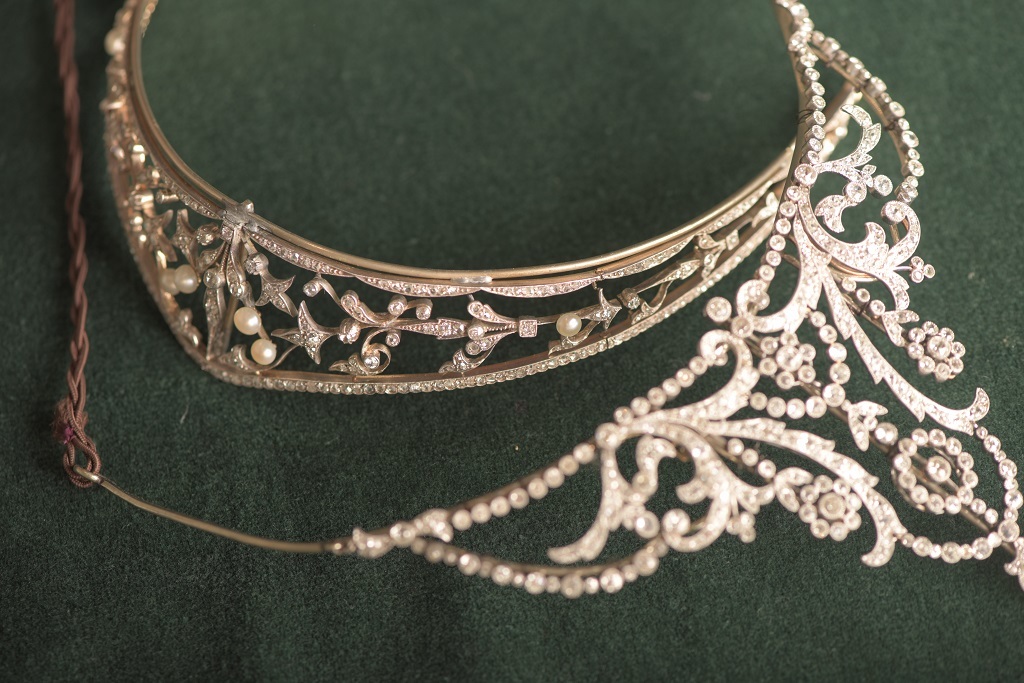
A gem of an idea became a thriving business
Classic jewellery from a bygone age has a very distinctive look and feel to it.
But the passing of time results in it becoming tarnished and damaged, through wear and tear or accidents.
When diamonds lose their dazzle, silver stops shining and gold no longer glistens, there can be a temptation to go for a quick and easy fix, which may not cost the world, to get the item back into a decent-looking condition in the short term.
But sometimes, the cheap and nasty fix can result in jewellery that will, in turn, look cheap and nasty, when it genuinely has far more class than that.
Restoring beautiful pieces to their former state is just one of the tasks that is undertaken at Edinburgh’s Denzil Skinner and Partners, based in William Street.
Denzil is a founding partner of Denzil Skinner & Partners LLP which was established in 2012. The partnership brings together unique skills set within the jewellery trade through the experience he gained whilst at Hamilton & Inches in silverware, alongside Amanda Egerton-King.
Amanda gained a degree in Jewellery design from Central St Martin’s, the UK’s leading jewellery design college followed by running her own business in London during 1990s.

The unrestored tiaras which were brought to Denzil Skinner and Partners
After a career of some 20 years spent at Edinburgh jewellers, Hamilton & Inches during which he was responsible for developing the company’s silver workshop to become a leading UK contemporary silverware maker, Denzil left that business in 2010 to pursue new interests.
After period spent in London during which time Amanda established, with a friend, a creative jewellery design business, Paragon Jewellery, producing a range of ready made pieces along with providing a bespoke service. In 1998 Amanda and her partner, Sarah, closed the business when Amanda moved abroad with her husband and young family.
Amanda and Denzil bumping into each other was an opportune moment, Amanda had returned to Scotland and was considering her options when whilst out walking her dog she bumped into Denzil. What should have been a 40 minute walk on a rather dreich day lasted three hours during which the pair hatched a plan to launch a new business, Denzil Skinner and Partners was born. The business launched in September 2012, moving into its present premises in Edinburgh’s West End at 45 William Street in last year.
Denzil and Amanda have had their skills tested of late, when a family brought them a pair of tiaras, one of which they wanted to restore, and then sell the other.
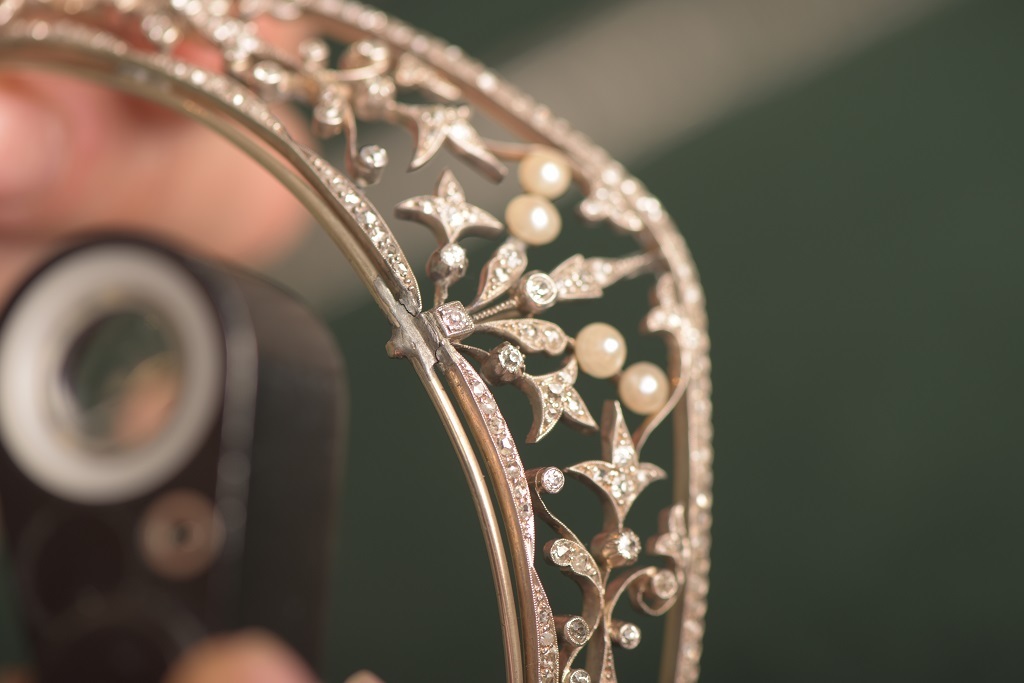
Denzil inspects the tiara for signs of damage
On closer examination, one of the tiaras was revealed to have previously been a necklace, which was altered to become a tiara.
The family wanted to keep the ‘proper’ tiara, and then sell the other. The former necklace could be broken up to form a new necklace, or become various other items smaller items of beauty.
But this wasn’t an issue for Denzil or Amanda, as he explains: ‘It’s almost a form of recycling that we do.
‘If they want to keep it and reuse the it, the first thing to do is to speak to a client, and Amanda sits with them, and does some design drawings.
‘In this instance, we have two tiaras, one of which has been really badly “restored”. It’s a really pretty little thing, but as you would expect over a number of years, it has been broken. In the old days, you would repair something with lead, but now, we’ve advanced enough to use lasers – and the lead looks horrible.
‘To begin with, you now have to wash the lead off with acid, before you start the restoration.
‘In this case, the family have two tiaras, one of which was a necklace which was turned into a tiara, so to help finance this restoration, we are going to retain the one that was a necklace, restore it to its original form, and sell it. This is a classic thing that we to do old jewellery, we remodel it.
‘The tiara will be from the mid-Victorian period, and the necklace is probably Edwardian. White gold didn’t happen in Victorian times. It’s been held together with wire, but you can easily take it apart.
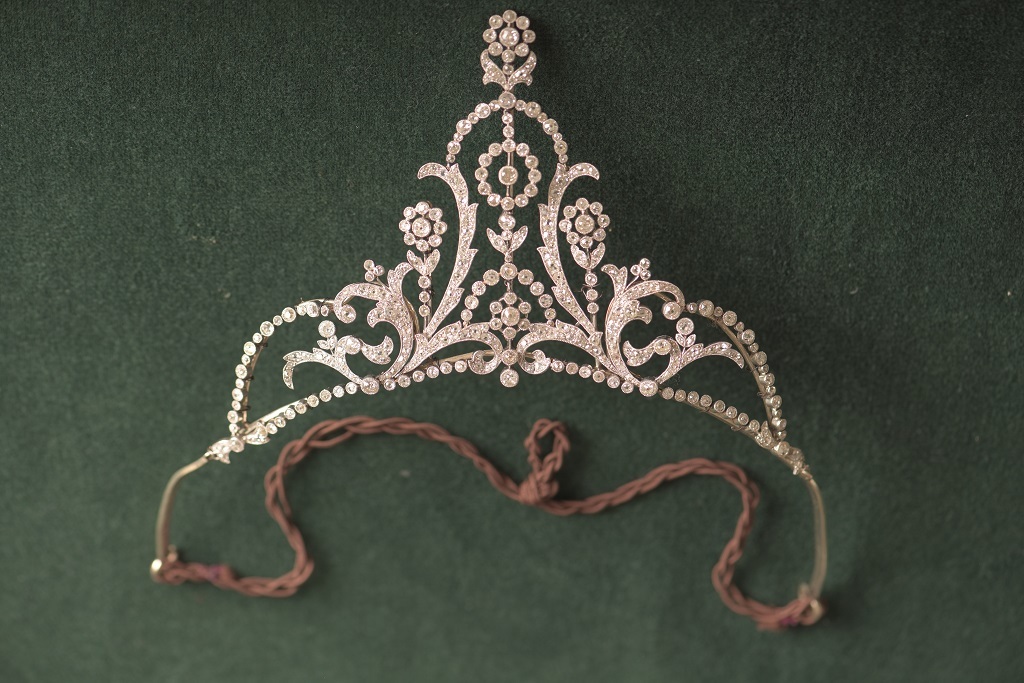
The necklace which was converted into a tiara
‘This is the second time we have worked on tiaras – we’ve been here for five-and-a-half years. The first tiara we worked on was one which we remodelled. We reworked the whole piece and created a smaller tiara from a larger one. We had eight pieces of jewellery from which Amanda did the designs, making the rest of it into earings, brooches and pendants. We sold three of the stones, which financed all of the work, and gave the client some money too.
‘Some of the jewellery we work with is quite traditional as we extract it, but a couple of the other pieces became quite modern.’
Showing Scottish Field the converted necklace, he said: ‘This should never have been made into a tiara – it was always meant to be a necklace. I would suspect that the family had a party going on and they needed a second tiara, to go with the original one they already had. Someone must have looked at this necklace and decided they wanted it to become a tiara. Looking at it, you really wouldn’t want to wear it.
‘Fortunately, this conversion has been done in such a way that we can take the back of the frame off. The frame was made and the pieces of the necklace were then wired to it. In doing so, quite a few of the jump rings holding the necklace together have been cut.
‘We will inspect it carefully, to make sure the jump rings are free and will then need to give it a good clean and ensure it has a chain which goes round the back of the neck – when you look at it in its original form as a necklace, you can see what a beautiful thing it is.
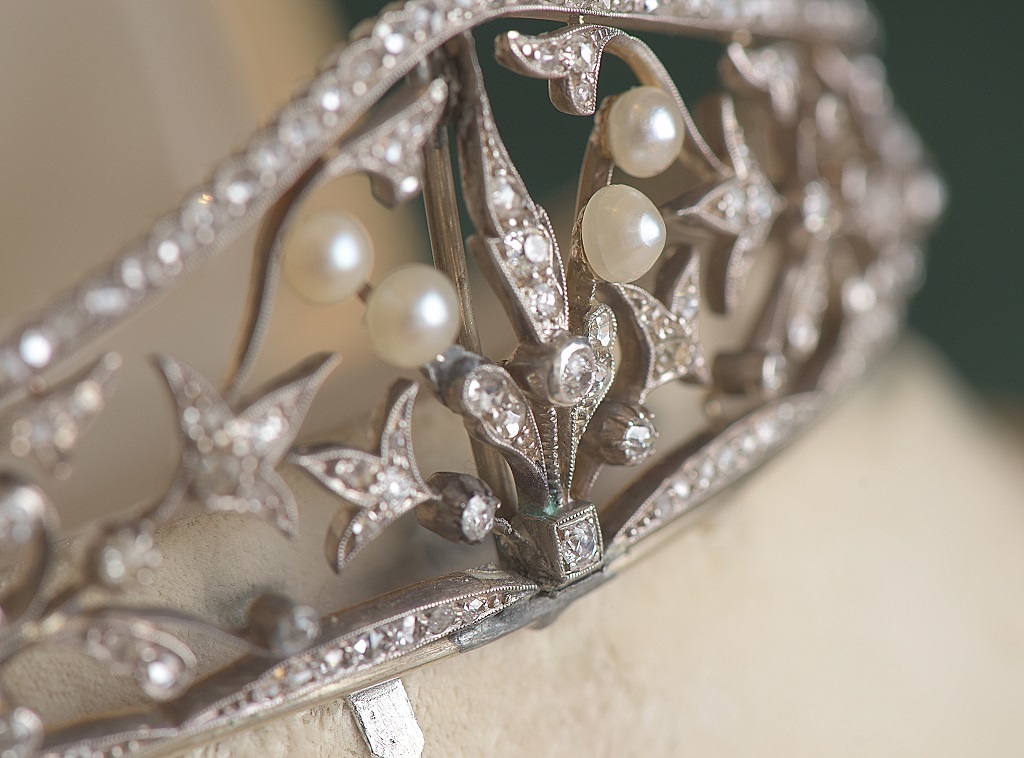
Fine detail on the tiara
‘The family who own it don’t want to restore it to its former glory, so we will sell it privately for them.
During its brief existence Denzil Skinner & Partners have been responsible for creating many pieces of jewellery, sometimes using gems sourced specifically but often taken from unworn inherited jewellery – and remodelling of old pieces has become a central part of the business.
This is where Amanda brings a depth of knowledge and skill to the business and is the principle designer.
Amanda is especially happy when surrounded by gem stones sketch pad to hand, talking to clients, discussing ideas and refining into firm designs, she produces the most exquisite hand drawn and painted designs which are prepared for each commission and allow the customer to envisage what the outcome will be – transforming a client’s dream into a design to be enjoyed for many a year.
Denzil continued: ‘Amanda will take photographs and give an explanation of what she thinks she should do. She will sit down with the customer and do some detailed drawings.
‘You can take the stones from something and create something new, so that way you retain the sentiment of the original piece, especially if it is a family heirloom. Sometimes, you can sell the gold which will help offset the cost of creating a new piece.
‘For example, from one brooch, we were able to create two pairs of earrings, potentially three rings and a pendant. That’s six pieces of jewellery from one, but they were all designed so they become relevant and the stones can be enjoyed again. Sometimes, you can get 10 pieces from one – it’s all about upcycling the jewellery.’
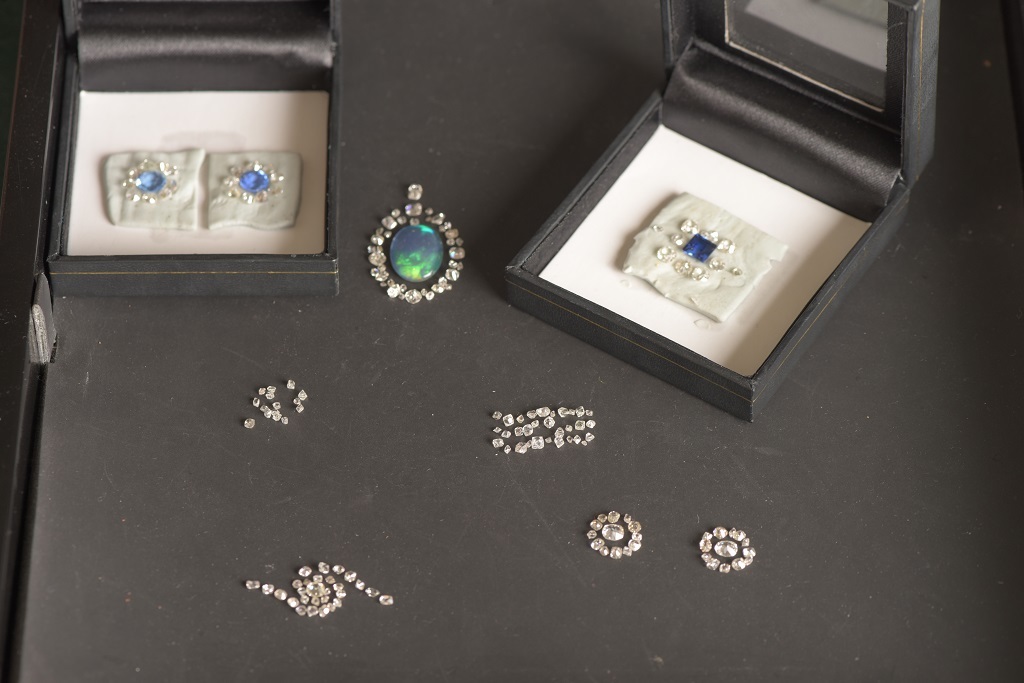
Amanda creates new jewellery from old
Restoring the constituent parts of the piece itself takes a lot of work too.
Denzil said: ‘In Victorian times, with a white diamond, you would put it in white metal, as you wouldn’t want the yellow of traditional gold to reflect through the stone. They didn’t have white gold then, so they sat everything in silver. Silver, however, tarnishes, and becomes duller. In restoring, we will work on the silver so it becomes lovely and bright again.
‘With the necklace, it’s set in platinum, which came in around the time of World War I. Jewellers learned how to work it and this is really delicate. Platinum is much harder.
‘The workmanship is beautiful and I feel really privileged to see such beautifully-made things.
‘The craftsmen are around that can do this, but there are so very few of them. There was a time when this could be made by lots of people, but now, there’s maybe 20 in the whole of the UK.
‘When you make something like this, you have the jewel mounter who makes this out of the stones and then it goes to the setter. They are two very distinct sets of skills. You won’t get a mounter who will set first, and you won’t get a setter who will mount. A setter is one of the highest-paid people in our trade. A good setter will be working with no shortage of trade. They will set it so the angles are right and look its best from the optimum angle.’
Denzil believes the tiara/necklace isn’t the only piece of its kind in Scotland.
He added: ‘I’m sure there will be lots of safes and bank vaults up and down the country, which are full of these things, and their owners will be wondering what on earth to do with them.
‘They will be paying the insurance on them, year after year, and they are just sitting there.
‘With some work, we are able to retain the sentimental value of these items, and create something new from them.
‘Restoration in the last 30 years has changed dramatically, with the traditional skills embracing modern technology.
‘We do very specialised work, and we are very conscious that we must give very balanced advice to people before the make a decision on their property, before it becomes irreversible. We don’t want to destroy a piece, when there’s no going back from there.
‘We have turned around and told people in the past that pieces could be worth more as they are than they would be if we were to unset all the diamonds in it. You would sometimes do better selling as it is.’
TAGS

